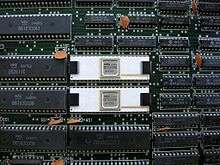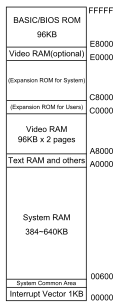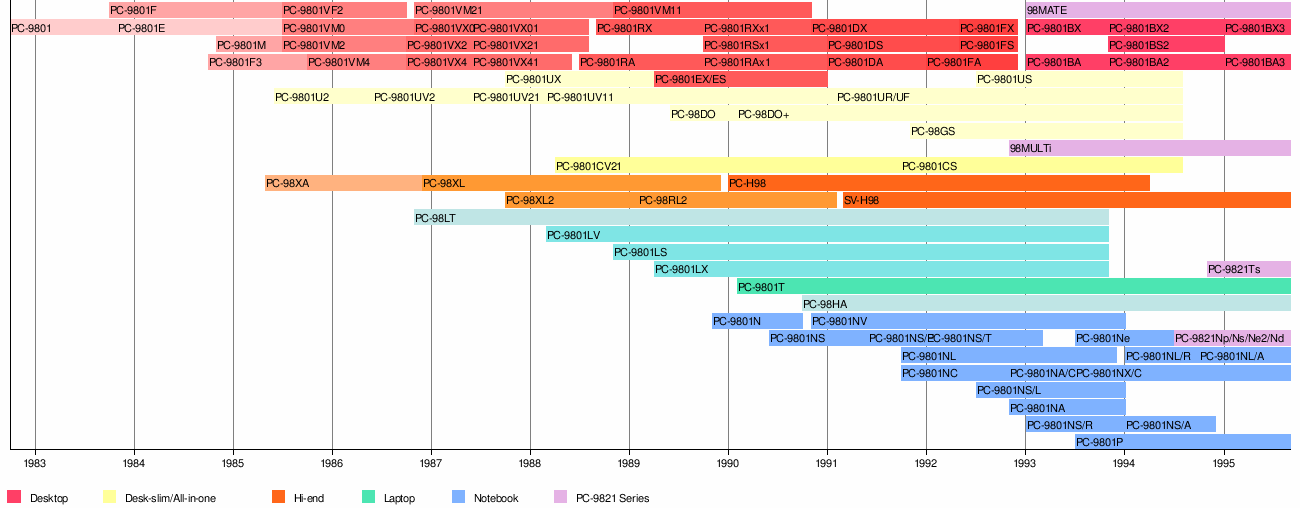PC-9800 series
|
PC-9801RX with the Intel 80286 | |
| Type | Personal computer |
|---|---|
| Release date | October 1982 (PC-9801) |
| Introductory price | ¥298,000 |
| Discontinued | 2003[1] |
| Operating system | CP/M-86, MS-DOS, OS/2, Windows |
| CPU | 8086 @ 5 MHz and higher |
| Memory | 128 kilobytes and higher |
| Predecessor | PC-8800 Series |
The PC-9800 series (Japanese: PC-9800シリーズ Hepburn: Pī Sī Kyūsen Happyaku Sirīzu), commonly shortened to PC-98, is a lineup of Japanese 16-bit and 32-bit personal computers manufactured by NEC from 1982 through 2000. The platform established NEC's dominance in the Japanese personal computer market, and by 1999, more than 18 million PC-98 units had been sold.[2]
History

The first model, the PC-9801, was launched on October 1982,[3] and employed an 8086 CPU. It ran at a clock speed of 5 MHz, with two µPD7220 display controllers (one for text, the other for video graphics), and shipped with 128 KB of RAM, expandable to 640 KB. Its 8-color display had a maximum resolution of 640×400 pixels. Its successor, the PC-9801E, which appeared in 1983, employed an 8086-2 CPU, which could selectively run at a speed of either 5 or 8 MHz. The NEC PC-9801VM used NEC V30 CPU.
When the PC-9801 was launched in 1982, it was initially priced at 298,000 yen (about US$1,200 in 1982 dollars).
In the 1980s and early 1990s, NEC dominated the Japan domestic PC market with more than 60% of the PCs sold as PC-9801 or PC-8801. In 1990, IBM Japan introduced the DOS/V operating system which enabled displaying Japanese text on standard IBM PC/AT VGA adapters. After that, the decline of the PC-98 began. The PC-9801's last successor was the Celeron-based PC-9821Ra43 (with a clock frequency of 433 MHz, using a 440FX chipset-based motherboard design from 1998), which appeared in 2000.
While NEC did not market these specific machines in the West, it did sell the NEC APC III, which has similar hardware as early PC-98 models.[4]
Hardware

The PC-98 is different from the IBM PC in many ways; for instance, it uses its own 16-bit C-Bus instead of the ISA bus; BIOS, I/O port addressing, memory management, and graphics output are also different. However, localized MS-DOS or Windows will still run on PC-9801s.
Clones
Seiko Epson manufactured PC-9801 clones, as well as compatible peripherals.[5]
Software
Software for the PC-98 generally ran from program and data disks (Disk 0 & 1 or A & B), and NEC did not have a strong GUI to go up against Microsoft's Windows 95 when it took Japan's PC market by storm. NEC's decision to work with Microsoft to offer a PC-98 compatible version of Windows 95 could be seen as the first step towards the PC-98's downfall, as consumers were no longer required to have an NEC-built system to run software designed for Windows.
The PC9801 had thousands of game titles designed for it, many of which made creative use of the system's limitations (it was originally designed as a business machine) to great commercial success. Despite having hardware specifications far inferior to the Fujitsu FM Towns and Sharp X68000 personal computers, the massive install base and steady flow of game titles (in particular "dōjin" style dating sims and RPGs, as well as early games of the Touhou Project franchise) kept it as the favored platform for PC game developers in Japan until the rise of the DOS/V clones.
NEC kept much of its hardware and platform proprietary or under license, so while it had a virtual monopoly in the Japanese market, later IBM PC clones with DOS/V and Windows from companies such as Hitachi and Panasonic that did not require such license fees (like Epson's 98 clones) flooded the market and displaced NEC. The proprietary technology that was NEC's strength turned into its weakness as its competitors could use off-the-shelf technology to build cheaper IBM PC clones at a time when NEC was charging much steeper prices for its PC-98s.
Models
Partial list of PC-98 models sold in the Japanese market (no 1992-2000 models, no notebook models, etc.).
| Model | CPU | Year | Features | Other |
|---|---|---|---|---|
| PC-9801 | 8086 5 MHz | 1982 | RAM 128 KB, 6 slot C-bus | 640×400 8 colors, 2 externals floppy drive 8" (optional) 298,000yen |
| PC-9801E | 8086-2 5/8 MHz | 1983 | 2 externals floppy drive 8" (optional) | |
| PC-9801F | 8086-2 5/8 MHz | 1983 | F1 and F2 with 128KB of RAM, F3 256 KB of RAM and hard-disk 10 Mb | Internal floppy drive, 5" 2DD (640KB/720KB) |
| PC-9801M | 8086-2 5/8 MHz[6] | 1984 | M1: 2 internal floppy drive, 5" 2HD (1MB/1.2MB); M2: 1 internal floppy and HD 20Mb | |
| PC-9801VF | NEC V30 8 MHz | 1985 | RAM 256 KB | double 5" floppy-disk 2DD resolution 640×400 with 8 colors (16 colors optional) chosen from among the 4096 available |
| PC-9801VM | NEC V30 10 MHz | 1985 | RAM 384 KB | double 5" floppy-disk 2HD/2DD resolution 640×400 with 8 colors (16 colors optional) chosen from among the 4096 available |
| PC-9801VX | 80286 8-10 MHz | 1986 | RAM 1 MByte | resolution 640×400 with 16 colors chosen from among 4096 |
| PC-9801U | NEC V30 8 MHz | 1985 | 2 floppy-disk 3.5" 2DD | |
| PC-9801UV | NEC V30 10/8 MHz | 1986 | 2 floppy-disk 3.5" 2HD/2DD | |
| PC-9801UX | 80286 10 MHz | 1987 | 2 floppy-disk 3.5" 2HD/2DD | |
| PC-9801RA | 80386DX 16-20 MHz | 1988 | 2 floppy-disk 5" 2HD/2DD | |
| PC-9801RS | 80386SX 16 MHz | 1989 | 2 floppy-disk 5" 2HD/2DD | |
| PC-9801RX | 80286 12 MHz | 1988 | 2 floppy-disk 5" 2HD/2DD | |
| PC-9801ES | 80386SX 16 MHz | 1989 | ES2 no HD, ES5 HD 40MB | 2 floppy-disk 3.5" 2HD/2DD |
| PC-9801EX | 80286 12 MHz | 1989 | 2 floppy-disk 3.5" 2HD/2DD | |
| PC-9801DA,DA/U | 80386DX/20 MHz | 1990 | /U means 3.5" floppy No /U means 5" floppy | |
| PC-9801DS,DS/U | 80386SX/16 MHz | 1990 | /U means 3.5" floppy No /U means 5" floppy | |
| PC-9801DX,DX/U | 80286 12 MHz | 1991 | /U means 3.5" floppy No /U means 5" floppy | |
| PC-9801FA,FA/U | 80486SX/16 MHz | 1992 | F means "File slot", memory proprietary expansion slot | |
| PC-9801FS,FS/U | 80386DX/16 MHz | 1992 | ||
| PC-9801FX,FX/U | 80386SX/16 MHz | 1992 | ||
| PC-9821 | Intel 80386SX | 1992 | RAM 4 MByte, drive CD-ROM | hard disk 40 MByte, resolution 640×480 with 256 colors and SCSI interface, Windows 3.0 pre-installed |
| PC-9821Ce | 80486SX 25 MHz | 1993 | Windows 3.1 pre-installed | |
| PC-9821Ce2,Cs2 | 80486SX 25 MHz (Ce2)/33 MHz (Cs2) | 1994 | ||
| PC-9821Cx | 80486SX 33 MHz | 1994 | MS-DOS 5.2/Windows 3.1 pre-installed | |
| PC-9821Cf | Pentium 60 MHz | 1994 | built-in TV tuner, MS-DOS 5.0/Windows 3.1 pre-installed | |
| PC-9821Cx2 | Pentium 75 MHz | 1995 | CD-ROM 4x drive | hard disk 850 MByte, built-in TV tuner, MS-DOS 6.2/Windows 3.1 pre-installed |
| PC-9801Cx3 | Pentium 100 MHz | 1995 | Windows 95 pre-installed | |
| PC-9821Ra43 | Celeron 443 MHz | 2000 | Last computer of series |
Timeline of PC-9801 models

See also
References
- ↑ "PC-9800シリーズ受注終了のお知らせ" [PC-9800 Series Discontinuation Notification] (in Japanese). NEC. Retrieved June 7, 2016.
- ↑ "Computing Japan". Computing Japan. LINC Japan. 54-59: 18. 1999. Retrieved 6 February 2012.
...its venerable PC 9800 series, which has sold more than 18 million units over the years, and is the reason why NEC has been the number one PC vendor in Japan for as long as anyone can remember.
- ↑ John Szczepaniak. "Retro Japanese Computers: Gaming's Final Frontier". Hardcore Gaming 101. p. 2. Retrieved 2011-03-16. Reprinted from "Retro Japanese Computers: Gaming's Final Frontier", Retro Gamer (67), 2009
- ↑ "Old-Computers.com". Archived from the original on April 23, 2011. Retrieved 5 May 2011.
- ↑ "EPSON PC`s DATABASE TOP PAGE" (in Japanese). Retrieved June 10, 2016.
- ↑ "Photo of motherboard of PC-9801M".
Further reading
- Joel West and Jason Dedrick, "Innovation and Control in Standards Architectures: The Rise and Fall of Japan’s PC-98", Information Systems Research, Vol. 11, No. 2, June 2000, pp. 197–216
- Ascii Techwrite (1993). 改訂版 PC-9800シリーズ テクニカルデータブック HARDWARE編 [PC-9800 Series Technical Databook (Hardware, Revised Ed.)]. Ascii. ISBN 4756104568.
- Ascii Techwrite (1992). PC-9800シリーズ テクニカルデータブック BIOS編 [PC-9800 Series Technical Databook (BIOS)]. Ascii. ISBN 475610441X.
- Myers, Steven; Smith, Greg (March 1995). "DOS/V: The Soft(ware) Solution to Hard(ware) Problems". Computing Japan Magazine. Archived from the original on 2017-01-15. Retrieved 2017-01-15.
- Boyd, John (April 1997). "From Chaos to Competition - Japan's PC industry in transformation". Computing Japan Magazine. Archived from the original on 2017-01-16. Retrieved 2017-01-16.
External links
| Wikimedia Commons has media related to PC-9800 series. |
- Intro to NEC PC-9800 World
- PC 9801, the first model of the series
- Info about NEC PC-9801M with uPD8086D-2
- "PC博物館" [PC Museum] (in Japanese). Retrieved June 7, 2016.
- "With98 : PC-98データバンク" [With98 : PC-98 Data Bank] (in Japanese). (unofficial). Retrieved June 7, 2016.
- "モデルナンバー (本体) - PC-9800 - NEC - レトロPC - Retro Computer People" [Model number (computers) - PC-9800 - NEC - Retro PC - Retro Computer People] (in Japanese). Retrieved June 10, 2016.
- "なおちま屋 = 昔のカタログ保存館" [Naochima-ya - Old catalogue museum] (in Japanese). Retrieved June 10, 2016.
- Neko Project II, a PC-98 emulator for Windows and Mac OS X
| Preceded by PC-8800 Series |
NEC Personal Computers | Succeeded by |
